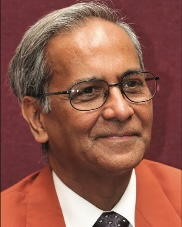P H I L O S O P H Y
VIVEKANANDA’S QUANTUM LEAP
______________________
His understanding of matter and energy anticipated the discovery of the quantum—key to the inevitable merger of modern science with spirituality
______________________
B Y J A Y L A K H A N I
SINCE CHILDHOOD, THE ASPECT OF RELIGION that attracted me most was its experiential side. Its narratives or liturgy had limited attraction for me. The religious personalities that captured my attention were those whose lives were guided by first-hand spiritual experiences, such as Ramana Maharshi and Sri Ramakrishna.
At the age of 17 I joined Imperial College in London to study physics. At the same time I came across the Complete Works of Swami Vivekananda. In the mornings I was exposed to the teachings of the most physical of physical sciences, and in the evenings I immersed myself in the spiritual stream that flows from the lectures of Vivekananda. During that period, many a day and night were filled with intense spiritual experiences. By the grace of my mentor, spiritual truths were no longer a matter of belief or intellectual acceptance; they became a reality for me. It was a real struggle to keep attending lectures focused on material science, but I persevered, and even went on to do a masters degree in quantum physics.
One of the greatest divides we face in this century is that between science and spirituality. On one side sits not one, but a multitude of religious world views; on the other side sits a more unified, science-oriented, rationally-founded worldview. A reconciliation is crucial, else the marvelous discoveries at the heart of all religions are in danger of being snuffed out by the far more popular human enterprise—science.
For a rationalist, the first issue is: “How can all religions be right?” They talk of different Gods or sometimes of no God. Either one religion is right, and the rest are in error, or quite likely the whole lot are in error! Vivekananda reconciled this disjoint in his address at the Parliament of Religions in Chicago. He suggested that at the experiential level all prophets encountered the same spirit, but a variation takes place when they try to give expression to their spiritual experiences. This variation is inevitable because it reflects a variation in the mindsets of different cultures in different historic periods. Over time, each expression ossifies into a religion or a different sect within the same religion. It is not that one is right and the rest are wrong—they are various attempts to infuse spirituality in greater society. This insight is popularly called religious pluralism. Religious pluralism recognizes variation in spiritual expressions and challenges exclusivist claims made by any religion.
Since the time of Vivekananda’s famous speech, religious pluralism has entered the social vocabulary. Recent surveys show that a large percentage of even evangelical Christians are comfortable with the concept of pluralism—and one of the main Shia Muslim groups in London recently published my article on pluralism on the front page of its publication! Without much drum beating or fanfare, pluralism has gently entered public consciousness.
The majority of youngsters I interact with at schools and colleges do not like to be called religious; they see themselves as being spiritual. When asked to explain what they mean by spiritual, they struggle, because it is difficult to intellectualize something that they feel is essentially intuitive. Most of them like humanism, but not necessarily the materialistic humanism promoted by the likes of Richard Dawkins. Without realizing, what they are actually attracted to is the spiritual humanism that Vivekananda promoted so strongly. Materialistic humanists see humanity as the extension of the material kingdom, while spiritual humanists see themselves as spiritual beings on a material journey.
I am making a robust attempt to reconcile the cutting-edge discoveries of modern science with the esoteric concepts at the heart of Hinduism. In the process I am challenging the paradigm of materialism. I offer well-received talks on this theme at various universities, including Oxford and Cambridge. I make no secret that the relevant and engaging material I bring out in my talks comes straight out of the Complete Works.
Let me just touch on one such notion that exhibits a clear link between science and spirituality and challenges materialism. At the heart of physics sits a marvelous discovery called the quantum. When it comes to understanding the fabric of reality, physics cannot do without the quantum. This discovery is far more relevant than all the other discoveries of science rolled together. It offers rigorous mathematical articulation of everything, from the workings of the computer chip to the structure of DNA. And yet, conceptually the same phenomenon remains a mystery. The reason why it so intriguing is because it insists that the underpinning to the world of matter scientists are so fixated on is essentially nonmaterial.
To get a conceptual grasp of the quantum we have to refer to one of the talks by Vivekananda on raja yoga. In this talk he said that the whole creation can be explained in terms of just two entities! The first is all penetrating existence (akash) and the second entity is a shudder in existence (prana). He gave this talk in 1895 when quantum was unheard of. Quantum physics insists that the world we see and experience as the empirical universe is not an objective reality but a multitude of wiggles in existence. I tell the physicists that the only way they can appreciate quantum is by giving up their fixation on matter and their attempt to explain the world in material terms. Science has entered a new phase, where matter has been severely demoted—in fact, it is valued as a mere appearance. Adi Shankara and Vivekananda must be smiling! A major paradigm shift is in the making—a shift that will merge science into spirituality.
JAY LAKHANI is Director of the Vivekananda Centre, London, and Education Director of the Hindu Council UK.


